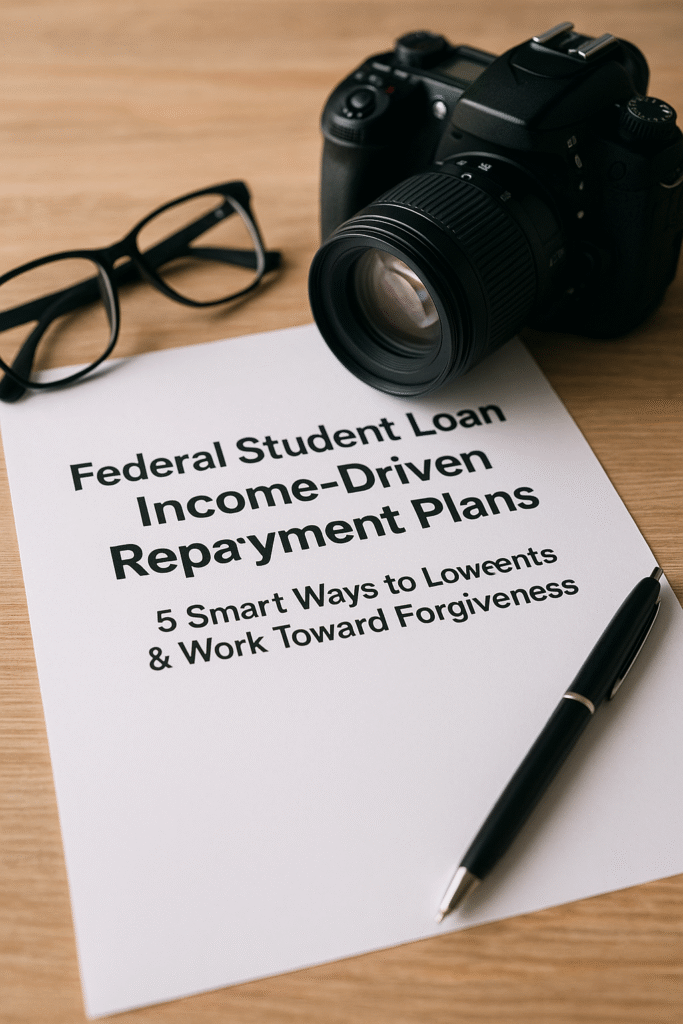Federal Student Loan Income-Driven Repayment Plans : Managing federal student loan payments can feel overwhelming—especially when budgets are tight. Thankfully, Income-Driven Repayment (IDR) plans like SAVE, PAYE, REPAYE, and IBR can make loans manageable and pave your path to forgiveness.
This interactive guide helps you compare these IDR plans, pick the smartest fit, apply confidently, and verify options using official government resources only. Let’s make federal loan repayment work for you — step by step.

What Is Income-Driven Repayment (IDR)?
IDR plans adjust your monthly federal student loan payment based on your income and family size. Key benefits include:
- Lower monthly payments—often 10–20% of discretionary income
- Protection from economic hardship
- Potential loan forgiveness after 20–25 years (or 10 years for public service workers)
Common plans include:
- SAVE (Saving on a Valuable Education) — the newest, most generous plan
- PAYE (Pay As You Earn) — capped at 10% of discretionary income
- REPAYE (Revised PAYE) — offers forgiveness and affects married couples’ payments differently
- IBR (Income-Based Repayment) — caps payments based on income and family size

Step 1: Know the Differences — At a Glance
| Plan | Payment Cap | Forgiveness Term | Key Feature |
|---|---|---|---|
| SAVE | 5% for undergraduate loans; 15% for grad | 20–25 years | Lowest payments + interest benefits |
| PAYE | 10% (max of Standard Plan amount) | 20 years (undergrad loans) | Requires loan (post-2007) |
| REPAYE | 10% (no cap) | 20 years (undergrad); 25 (grad) | Spouse’s income counts, even if separate filing |
| IBR | 10% (new borrowers) / 15% (older borrowers) | 20 years (new) / 25 years (older) | Available to most federal loans |
Step 2: Estimate Your Payment — Official Tool
Use the Federal Student Aid Estimator to compare plan payments:
Interactive Tip: Visit the official comparison tool to estimate your costs across all IDR plans: Repayment Estimator – Federal Student Aid
Step 3: Choose Your Best Fit
Ask yourself:
- Do you want the lowest possible payment? Try SAVE
- Are you pursuing public service career—PSLF path? PAYE or SAVE may fit best
- Is your spouse’s income significant? IBR or PAYE may be preferable over REPAYE
Step 4: Apply for Your Plan
- Log in to your account at studentaid.gov
- Choose “Manage Repayment Plan” and compare plans
- Select your plan and submit your income documentation (can be pay stubs or tax data via IRS auto-fetch)
- Confirm your servicer has updated your plan — check at [My Federal Student Aid Dashboard](https://studentaid.gov/myDirectLoan} (ensure correct link)
Step 5: Preserve Forgiveness Eligibility
- Qualify for Public Service Loan Forgiveness (PSLF)—requires enrollment in IDR plus employment in qualifying service for 10 years
- Always submit Employment Certification Forms annually to track qualification
- Use the official PSLF Help Tool: PSLF Help Tool – Federal Student Aid to track your progress
Step 6: Plan for Income Changes
Any income change may alter your IDR payments:
- Update your income annually or with major job or family changes
- Use your servicer’s portal or the StudentAid.gov portal
- Avoid accruing unpaid interest—especially if using SAVE, which has interest protections for low-income borrowers
Step 7: Monitor Your Loan Balance & Forgiveness Timeline
- Log in to studentaid.gov to track remaining payments and forgiveness date
- Keep an eye on annual statements provided by your servicer
- Set calendar reminders for 10, 15, 20, and 25 years from your enrollment in IDR to review progress

FAQs — Quick Answers
Can I switch plans later? Yes. You can change between IDR plans anytime during repayment.
Will refinancing disqualify me from forgiveness or IDR? Yes—ONLY federal loans can join IDR and PSLF paths.
Am I waived multiple payments during deferments? IDR adjusts payments based on income, so deferments still reflect your financial situation—but interest may still accrue.
Final Checklist Before You Switch
- Use the federal Repayment Estimator to compare plans
- Login to StudentAid.gov and view your current plan
- Upload income documentation (tax or pay stubs)
- Submit IDR plan change request with servicer
- Set up reminders for annual income recertification
- If pursuing PSLF, submit your Employment Certification Form
Disclaimer
This content is for informational purposes only and does not serve as legal or financial advice. Always review current details via the U.S. Department of Education’s Federal Student Aid portal or consult a financial aid advisor. All images used in this article are royalty‑free or licensed for commercial use and are provided here for illustrative purposes.
By tailoring your repayment plan to your income and long-term goals, you can lower monthly burdens and make meaningful progress toward forgiveness.
